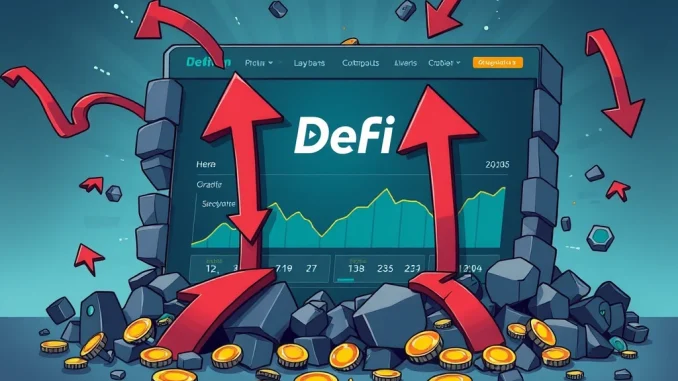
Are you watching your crypto investments closely amidst the recent market rollercoaster? If you’re involved in DeFi, especially lending and borrowing, you need to pay attention. A significant shift is underway in the decentralized finance landscape. Recent crypto market turmoil has sent shockwaves through DeFi borrowing platforms, leading to a dramatic decrease in demand. Let’s dive into what’s happening and what it means for you.
Why is DeFi Borrowing Plunging? Unpacking Crypto Market Turmoil
The recent turbulence in the cryptocurrency market isn’t just about price drops; it’s triggering a fundamental shift in investor behavior within DeFi. Specifically, the demand for DeFi borrowing has taken a nosedive. Think of it like this: when the market gets shaky, people tend to reduce their risks and leverage. And in the crypto world, leverage often comes from borrowing.
Here’s a breakdown of the key factors contributing to this plunge:
- Investor Deleveraging: Market uncertainty prompts investors to reduce their exposure by paying back loans. This is a classic ‘risk-off’ move. When prices are volatile, the fear of liquidations increases, pushing users to deleverage proactively.
- Liquidation Fears: As crypto prices fall, the value of collateral used for borrowing also decreases. This can trigger liquidations, where platforms automatically sell off collateral to cover debts. The increased number of liquidations we’re seeing further fuels the deleveraging trend.
- Reduced Trading Activity: Market downturns typically lead to lower trading volumes. Less trading means less need for borrowed funds, which are often used for leveraged trading strategies.
- Yield Adjustments: As borrowing demand decreases, the yields offered on lending platforms also tend to fall. This makes borrowing less attractive and lending less lucrative, contributing to an overall cooling down of the DeFi lending and borrowing space.
Aave and Morpho Feel the Heat: DeFi Giants See Borrowing Demand Evaporate
Major DeFi platforms like Aave and Morpho are at the forefront of this shift. Let’s look at the numbers:
According to data from DefiLlama, a leading analytics platform for decentralized finance:
- Aave: Total borrowed assets on Aave have plummeted from over $15 billion in mid-December to around $10 billion. That’s a staggering $5 billion reduction!
- Morpho: Similarly, Morpho has seen a significant decrease, with borrowed assets falling from $2.4 billion to $1.7 billion.
These figures clearly illustrate the dramatic impact of the recent crypto market turmoil on even the most established DeFi platforms. The scale of the decline underscores the broad-based nature of investor deleveraging.
Stablecoin Yields at Rock Bottom: The Shrinking Returns of DeFi Lending
Another indicator of the cooling DeFi borrowing market is the decline in stablecoin yield. Stablecoin yield refers to the interest earned by lending out stablecoins like USDT or USDC on DeFi platforms.
The average stablecoin yield across DeFi lending platforms has dropped to a meager 2.8%, the lowest it has been in a year. This signifies:
- Reduced Borrowing Demand: Lower yields are a direct consequence of less demand for borrowing stablecoins. Platforms don’t need to offer high incentives when fewer people are looking to borrow.
- Increased Loan Repayments: As users repay loans and face liquidations, the supply of available stablecoins for lending increases, further pushing yields down.
- Less Incentive to Lend: Lower yields make lending stablecoins less attractive compared to other investment options, potentially leading to capital moving out of DeFi lending platforms.
Liquidation Cascade: Forced Liquidations Soar on Aave and MakerDAO
The crypto market turmoil has not only reduced borrowing demand but also triggered a wave of liquidations. Platforms like Aave and MakerDAO have processed significant amounts of forced liquidations as collateral values dipped below required thresholds.
Key highlights from recent liquidation events:
- Aave Liquidations: Aave alone processed over $110 million in forced liquidations. This massive figure highlights the scale of the deleveraging and the impact of price volatility on leveraged positions.
- MakerDAO Liquidation: MakerDAO, another prominent DeFi platform, liquidated a substantial $74 million ETH-backed DAI loan, as reported by CoinDesk. This single liquidation event underscores the risks associated with borrowing against volatile assets like Ethereum (ETH).
These liquidations serve as a stark reminder of the inherent risks in DeFi borrowing, especially during periods of crypto market turmoil. While liquidations are a necessary mechanism to maintain the solvency of these platforms, they can be painful for individual users who find their collateral automatically sold off.
Navigating the DeFi Downturn: Actionable Insights for Crypto Users
So, what does all this mean for you, the crypto user?
Here are some actionable insights to consider as you navigate this period of reduced DeFi borrowing and market uncertainty:
- Re-evaluate Your Leverage: If you have open borrowing positions in DeFi, now is the time to carefully assess your risk. Consider reducing your leverage to avoid potential liquidations in case of further market downturns.
- Monitor Collateral Ratios: Keep a close eye on the health of your collateralized debt positions. Ensure your collateral ratio is comfortably above the liquidation threshold to provide a buffer against price drops.
- Explore Stablecoin Lending Alternatives: With stablecoin yields declining in DeFi, explore other potential avenues for earning yield on your stablecoins, while being mindful of the associated risks.
- Stay Informed: Keep yourself updated on market trends and developments in the DeFi space. Platforms like DefiLlama and CoinDesk provide valuable data and news to help you make informed decisions.
Conclusion: DeFi Borrowing in a New Era
The sharp decline in DeFi borrowing amid crypto market turmoil signals a significant shift in the DeFi landscape. While the long-term future of DeFi remains bright, periods of market volatility expose vulnerabilities and trigger necessary adjustments. The current deleveraging trend and reduced stablecoin yields are not necessarily negative signs. Instead, they represent a recalibration of the market, potentially leading to a more sustainable and resilient DeFi ecosystem in the long run.
As the crypto market evolves, understanding these shifts in DeFi borrowing dynamics is crucial for investors and participants alike. By staying informed and adapting your strategies, you can navigate these turbulent times and position yourself for future opportunities in the ever-changing world of decentralized finance.



